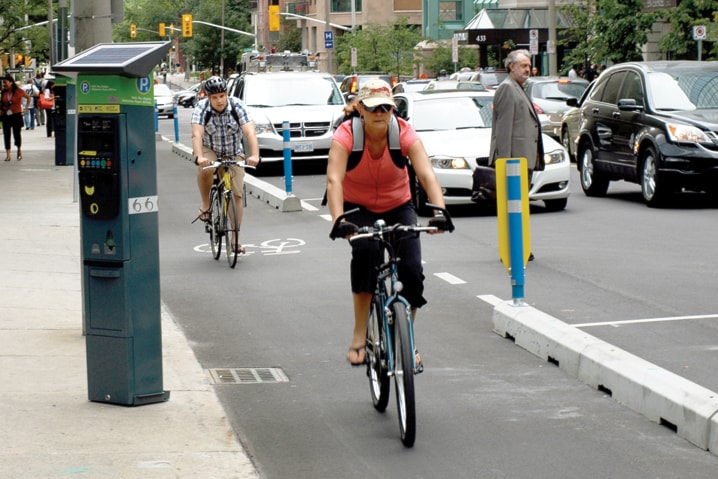Bike lanes come in many shapes and sizes throughout North America and Europe. The simplest and most common kind is a solid white line separating the cyclist from the traffic. This is what we are going to see in Red Deer this summer.
We are hoping that the new bike lanes will encourage people to use their bikes to commute instead of always dragging the car out of the garage. Let’s face it, bikes are better for your health and for the environment than your car is.
The problem is that many people do not feel safe cycling in a lane with nothing but a white line between them and the vehicles. They want some kind of physical separation between them and the vehicle traffic. They want “segregated bike lanes” that are becoming more and more popular throughout North America and Europe — usually only in cities where there is already a well established network of bicycle lanes.
One of the least expensive and least obtrusive ways to separate motor vehicles from cyclists is the use of bollards. These are relatively inexpensive and are obvious enough to motorists that the cyclist can feel much safer. The problem is that during the winter, they must be removed for snow clearing.
Cycle tracks are more completely separated from vehicle traffic, often by a median with cement curbs and planted trees. They encourage people to commute by bicycle because they are perceived as being very safe.
In cities like Copenhagen where extensive measures have been taken to encourage people to give up their cars in favor of bicycles it works. Copenhagen is famous for the percentage of people who ride bicycles because city planners have intentionally made it more difficult to drive a car than ride a bicycle.
Cycle tracks may appear to be safer. The risk of being struck from behind by a vehicle is obviously greatly reduced because a car would have to drive over the median to get at the cyclist.
But a study in Montreal found that cycle tracks are not safer than ordinary bike lanes at intersections. The motorist is not as aware of the cyclist on the cycle track at the intersection because the cyclist is a little further removed than when on the road.
So which is safer, a segregated bike lane or a painted bike lane on the road?
Traditionally, most accidents happened at intersections. However it could be argued that with the increase of people texting while driving, being hit from behind by a distracted driver is becoming an increasing menace.
The question of building cycle tracks in Red Deer is a rather moot point at this time anyway because the City is only just beginning to look at cycling and bike lanes as a viable form of alternative transportation. Cycle tracks are very expensive both in terms of money and space.
Some councillors are not convinced that there are enough cyclists to make bicycle lanes worthwhile. They are most certainly not prepared at this time to build cycle tracks.
This is a kind of chicken-and-egg problem. Why should we invest in commuting by bicycle if there are no cyclists? On the other hand, why would people commute by bicycle if they don’t feel safe?
Do people need cycle tracks to feel safe enough to commute by bicycle? Most cities begin with simple bicycle lanes, and research is showing that they are just as safe and perhaps even safer than segregated bike lanes.
It is hoped that the bike lanes for Red Deer are completed by the middle of August.
John Johnston is a member of the Red Deer Association for Bicycle Commuting, and an advocate for cyclists with the city’s planning group for transportation.
